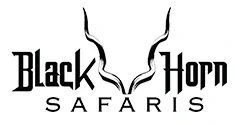Blue Wildebeest hunting is a thrill that draws enthusiasts from around the globe to the vast bushveld of Africa. Renowned for their formidable size, toughness, and distinctive physical characteristics, the Blue Wildebeest, also known as the Common Wildebeest or Brindled Gnu, presents a challenging yet rewarding trophy for the safari hunter. This species is characterized by its dark, slate-grey body, brindled with darker stripes, and its large, beautifully curved horns. Safari Hunters are typically drawn to the Blue Wildebeest for the challenging experience it offers, combined with the demands of tracking and stalking this agile and wary animal in the beauty of the African bush. In this article we provide everything you need to plan including prices, packages and best areas for Blue Wildebeest.

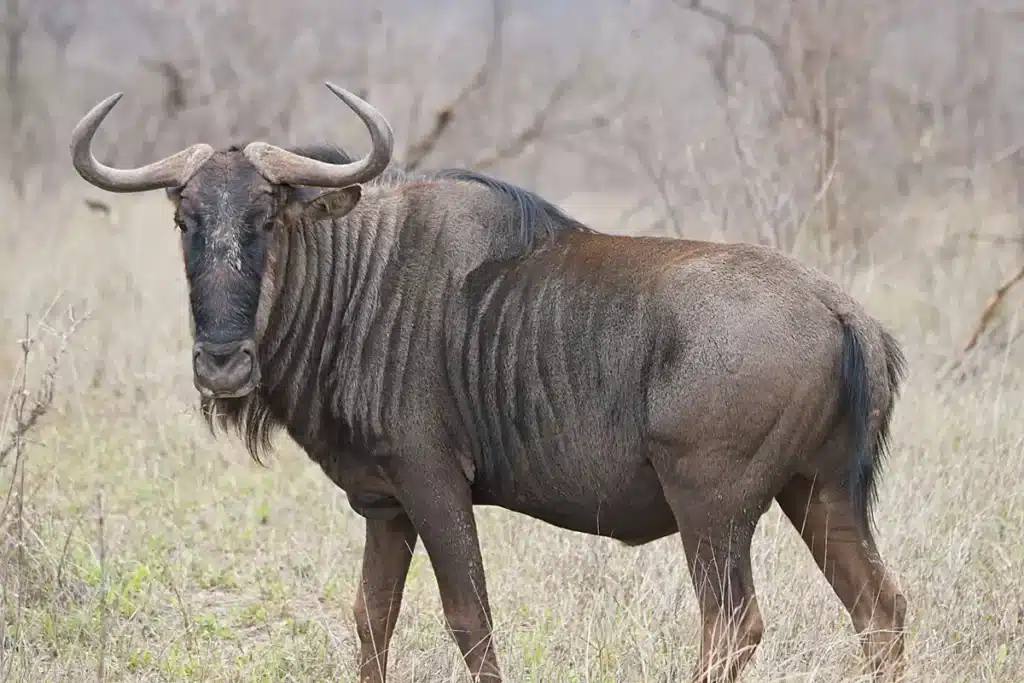
Description and Characteristics
The Blue Wildebeest, scientifically known as Connochaetes taurinus, is a large and powerfully built antelope native to the grasslands and bush of eastern and southern Africa. Its unique physique is marked by a broad, muscular chest, a short and stocky neck, and long, slender legs. Its coat is silvery-blue to dark grey, often adorned with vertical dark grey stripes, hence the name ‘Brindled Gnu’. The adult males can weigh up to 280 kg, while females are slightly lighter, weighing up to 235 kg. The Blue Wildebeest is also recognized by its formidable, curved horns, which are present in both bulls and cows but are more prominent males. These horns can reach a length of 30 inches in bulls and serve as a powerful weapon in territorial disputes and defense against predators. The Blue Wildebeest is a social species, often found in large herds. The Blue Wildebeest is known as “the poor man’s Buffalo” among Professional guides for it’s tenacity and ability to soak up lead.
Blue Wildebeest Trophy Size
A Blue Wildebeest trophy is usually evaluated based on the size and symmetry of the animal’s horns. The horns, which are present in both sexes but larger and more formidable in males, are one of the most distinctive features of this species. Safari Club International measures the trophy size of a Blue Wildebeest by using the length of the horn along the outer curve from the base to the tip, and the circumference of the horn’s base. A mature bull’s horns typically have a length ranging from 24 to 30 inches, with the record trophies exceeding the 36-inch mark. Exceptional specimens may also have a horn base circumference of around 10 inches. Minimum for entry into Rowland Ward record book is 28 4/8 and SCI a score of 70.
World Record
The world record Blue Wildebeest stands as a remarkable reminder of their growth potential. With an unbelievable RW (Rowland Ward) measurement of 36 inches and a SCI (Safari Club International) score of 99 3/4 inches, these unique individuals were certainly monsters among their species.
Best Locations for Hunting
South Africa, with its rich biodiversity and varied landscapes, is a prime destination for Blue Wildebeest. The Limpopo Province in the northern part of the country is one of the most popular regions, boasting vast expanses of bushveld that provides ideal habitat for Blue Wildebeest. The Eastern Cape also offers excellent hunting opportunities, with its mix of dense bush, open grassland, and mountainous areas. The Free State and North West provinces are known for their large concessions and private reserves, many of which host sizeable populations of Blue Wildebeest. KwaZulu-Natal, with its mix of savannah grasslands, bushveld, and wetland habitats, also offers Wildebeest hunting. It’s important to choose a reputable outfitter who follows ethical hunting practices and contributes to local conservation initiatives.
Rifles and Calibers for Hunting
Selecting the appropriate rifle and caliber for hunting Blue Wildebeest is crucial for a successful experience. Due to the Blue Wildebeest’s size, resilience, and tenacity, you should choose a caliber with sufficient knock down power and accuracy to ensure one-shot kill. A medium to heavy caliber rifle is generally recommended for hunting these sturdy antelope. Popular choices include the .30-06 Springfield, .300 Winchester Magnum, 7mm Remington Magnum, 9.3 X 62 and the venerable .375 H&H Magnum.
While lighter calibers such as the .270 Winchester may be adequate for experienced sportsmen, they might not provide sufficient stopping power for less experienced hunters. In addition to the caliber, hunters should use premium quality bullets with good weight retention and controlled expansion properties to maximize penetration and energy transfer. A minimum bullet weight of 180 gr. Is recommended, this also holds true for other plains game.


Rifle Scopes and Optics for Hunts
The selection of rifle scopes and optics for Blue Wildebeest is a significant factor in achieving a successful hunt. Given the varied terrain and shooting distances encountered when pursuing these formidable animals, a versatile scope is a necessity. A variable power scope, preferably in the range of 3-9x or 4-12x, is often the best choice. These rifle scopes provide the flexibility to make accurate shots at varying distances, whether it’s a close encounter in dense bushveld or a longer shot across the open grass plains. High-quality glass and coatings are essential for optimal light transmission, especially in low-light conditions at dawn and dusk when Wildebeests are often most active. Additionally, durability is a key consideration, as the scope should be able to withstand the recoil of the heavier calibers typically used for Wildebeest hunting.
Best Shot Placement on Wildebeest
Achieving the correct shot placement on a Blue Wildebeest is crucial for ethical reasons and ensuring a quick, humane kill. As a general rule, aim for the vital organs – the heart and lungs – which are located in the lower front quarter of the animal’s body, just behind the shoulder. A well-placed shot here will typically result in a quick demise. If the animal is standing broadside, the hunter should aim approximately one-third of the way up the body, directly behind the front shoulder. This should hit the heart and lungs, causing rapid blood loss and a quick death.
However, shot placement may need to be adjusted depending on the animal’s position. If the Wildebeest is quartering away, the shot should be placed so that the bullet travels through the vital organs. Aim for the offside front shoulder. If the animal is quartering towards the hunter, the shot should be placed at the front part of the shoulder, angling into the chest cavity to reach the vital organs.
The Blue Wildebeest’s robust build and tenacity for life when wounded necessitate a well-placed first shot. It’s also essential to understand that Wildebeests are tough animals and may not drop immediately, even after a well-placed shot. Be prepared to deliver a follow-up shot if required.
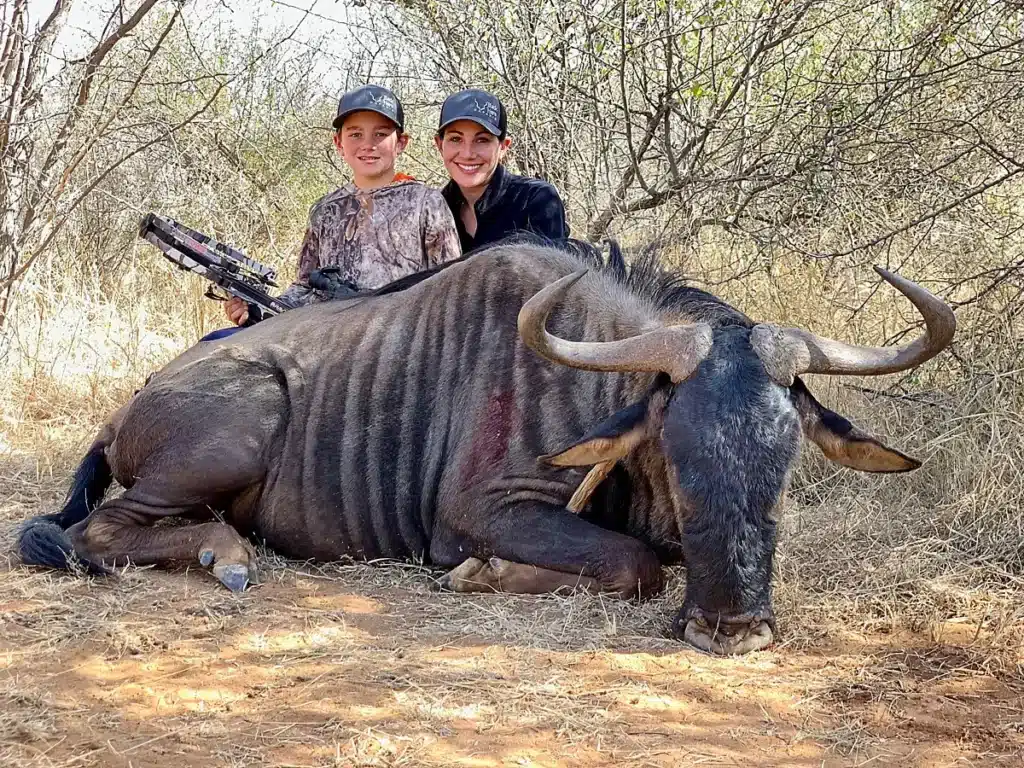
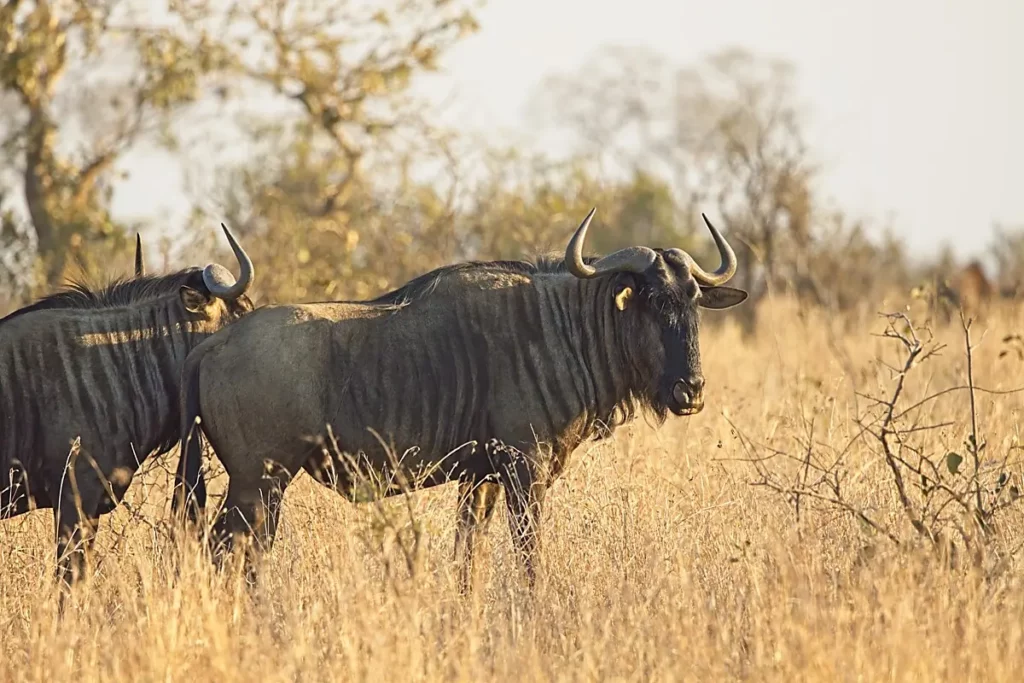
Bow Hunting the Blue Wildebeest
Bow hunting Blue Wildebeest presents its own set of unique challenges and rewards, requiring a high degree of skill, patience, and precision archery skills. The substantial size and resilience of the Blue Wildebeest demand a powerful bow with a higher draw weight. Shot placement is even more critical with bow hunting. Aim for the same vital area behind the front shoulder, but be aware that the “kill zone” is smaller and requires greater precision. Stealth and concealment are paramount when bow hunting, often from a ground blind or tree stand, as shots will typically be taken at much closer ranges than when shooting with a rifle, usually within 30- 40 yards.
Bow Hunting Equipment for Blue Wildebeest
When bow hunting Blue Wildebeest, the selection of appropriate and high-quality equipment is paramount for a successful and ethical hunt. The bow itself should ideally have a draw weight of at least 60 pounds, though 70 pounds is often recommended given the Wildebeest’s size and toughness. Compound bows are typically preferred due to their power, accuracy, and ease of use, though traditional archery bows can be used by skilled archers.
Arrows should be sturdy and well-crafted, usually made of carbon fiber for its strength and light weight. The total arrow weight (including the broad head) should be approximately 400-500 grains to ensure sufficient kinetic energy and penetration. Broad heads are a critical component, with fixed-blade or mechanical types being recommended. They should be razor-sharp, durable, and have a cutting diameter of at least one and a quarter inches to maximize damage to vital organs.
Finally, a portable tree stand or ground blind can provide a strategic advantage by offering concealment and an elevated shooting position. As always, proper practice and familiarity with your arrow trajectory is crucial before venturing on your hunt.
Blue Wildebeest Prices and costs of a Hunting Safari
The standalone price or trophy fee for a Blue Wildebeest is $ 1 350.00.
Day fees cost $ 350.00 per person per day if 2 clients will share the services of a Professional Hunter and $ 450.00 if you would prefer to have the services of the Professional Hunter to yourself.
A 5 day trip including a Blue wildebeest will cost $ 3 100.
Wildebeest Hunting Packages
- A Hunting Package including 7 days hunting and trophy fees for 1 X Blue Wildebeest, 1 X Zebra, 1 X Blesbok and 1 X Warthog will cost $ 6 300.00 if hunting 2 on 1.
- A Package hunt including 7 days hunting and trophy fees for 1 X Blue Wildebeest, 1 X Nyala, 1 X Impala, 1 X Blesbok and 1 X Warthog will cost $ 7 800.00 if hunting 2 on 1.
- Other plains game hunting packages are also available.
The above are all inclusive African hunting Safari package hunts and include:
- Accommodation in a hunt lodge,
- All meals,
- drinks,
- the services of a professional guide,
- skinning and field preparation of your trophies and
- road transportation to and from Johannesburg International Airport.
References
Estes, R. D. (1991). The Behavior Guide to African Mammals: Including Hoofed Mammals, Carnivores, Primates. University of California Press.
East, R. (1999). African Antelope Database 1998. IUCN/SSC Antelope Specialist Group.
Sinclair, A. R. E., & Mduma, S. (2003). The Serengeti wildebeest migration: a study in predation. Wildlife Conservation Society.
Owen-Smith, R. N. (2008). Megaherbivores: The Influence of Very Large Body Size on Ecology. Cambridge University Press.
Conclusion
In conclusion, Blue Wildebeest hunts are an exhilarating and challenging pursuit that provides sportsmen with a unique opportunity to engage with one of Africa’s most iconic and resilient species. The hunt requires careful preparation, including the selection of appropriate firearms or bow hunting equipment, knowledge of the animal’s habits and proficiency in shot placement. Whether through the satisfaction of a well-placed shot, the thrill of the stalk, or the profound connection with nature and the African bush, Blue Wildebeest offers an adventure that leaves a lasting imprint on those who engage in it.
FAQ’S Frequently asked Questions on Wildebeest Hunting
How much does a Blue Wildebeest Hunt Cost?
The cost of a Blue Wildebeest hunt can vary greatly depending on several factors, including the location and the duration of the hunting trip.
A typical safari in South Africa including a Blue Wildebeest will cost around $3,800 USD. This typically includes the services of a professional hunter, accommodation, meals, and transportation within the hunting area.
The trophy fee for a Blue Wildebeest, which is the cost associated specifically with hunting that animal, is $1,350 USD. However, these prices can change so consult the Hunting Outfitter about hunting packages.
Additionally, you should also account for other costs such as airfare, taxidermy, shipping of trophies and tips for the hunting staff.
What is the best Shot Placement on Wildebeest?
The best shot placement on Blue Wildebeest is through the heart and lungs – which are located in the lower front quarter of the animal’s body, just behind the shoulder. A well-placed shot here will typically result in a quick demise. If the animal is standing broadside, the hunter should aim approximately one-third of the way up the body, directly behind the front shoulder. This should hit the heart and lungs, causing rapid blood loss and a quick death.
What caliber rifle is best for Wildebeest?
Popular hunting rifle choices include the .30-06 Springfield, .300 Winchester Magnum, 7mm Remington Magnum, 9.3 X 62 and the reliable .375 H&H Magnum. While lighter calibers such as the .270 Winchester may be adequate for experienced sportsmen, they might not provide sufficient stopping power for less experienced shooters.
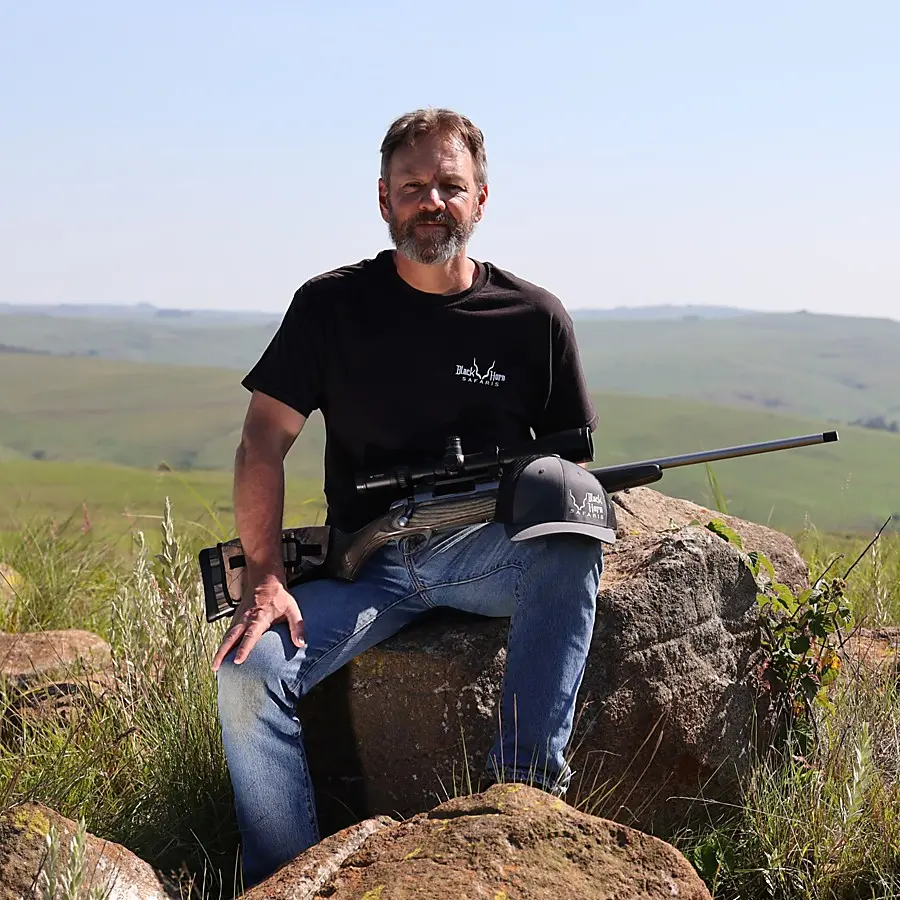
Adrian Anderson first obtained his Professional Hunters license in 1991. He is a Big Five and Dangerous Game licensed Professional Hunter and Hunting Outfitter. He has a tremendous love for wildlife and the African bush and enjoys sharing his knowledge with the hunting clients that he guides. Guiding hunters in Africa’s wild places is a passion and seeing them succeed with their goals brings satisfaction. With knowledge of the Safari industry built up over 32 years he is well qualified to give guidance to his hunting clients.
